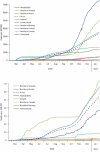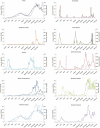The "second wave" of the COVID-19 pandemic in the Arctic: regional and temporal dynamics
- PMID: 34125008
- PMCID: PMC8205071
- DOI: 10.1080/22423982.2021.1925446
The "second wave" of the COVID-19 pandemic in the Arctic: regional and temporal dynamics
Abstract
This article focuses on the "second wave" of the COVID-19 pandemic in the Arctic and examines spatiotemporal patterns between July 2020 and January 2021. We analyse available COVID-19 data at the regional (subnational) level to elucidate patterns and typology of Arctic regions with respect to the COVID-19 pandemic. This article builds upon our previous research that examined the early phase of the COVID-19 pandemic between February and July 2020. The pandemic's "second wave" observed in the Arctic between September 2020 and January 2021 was severe in terms of COVID-19 infections and fatalities, having particularly strong impacts in Alaska, Northern Russia and Northern Sweden. Based on the spatiotemporal patterns of the "second wave" dynamics, we identified 5 types of the pandemic across regions: Shockwaves (Iceland, Faroe Islands, Northern Norway, and Northern Finland), Protracted Waves (Northern Sweden), Tidal Waves (Northern Russia), Tsunami Waves (Alaska), and Isolated Splashes (Northern Canada and Greenland). Although data limitations and gaps persist, monitoring of COVID-19 is critical for developing a proper understanding of the pandemic in order to develop informed and effective responses to the current crisis and possible future pandemics in the Arctic. Data used in this paper are available at https://arctic.uni.edu/arctic-covid-19.
Keywords: Arctic; COVID-19; mortality; pandemic; regions; trends; waves.
Conflict of interest statement
No potential conflict of interest was reported by the author(s).
Figures
References
-
- Lai S, Bogoch II, Ruktanonchai NW, et al. Assessing spread risk of Wuhan novel coronavirus within and beyond China, January-April 2020: a travel network-based modelling study. medRxiv. 2020.02.04.20020479; doi: https://doi.org/10.1101/2020.02.04.20020479.
-
- Yamana T, Pei S, Shaman J.. Projection of COVID-19 cases and deaths in the US as individual states re-open May 4, 2020. MedRxiv. 2020. 10.1101/2020.05.04.20090670. - DOI
-
- Dibner KA, Schweingruber HA, Christakis DA. Reopening K-12 schools during the COVID-19 pandemic: a report from the National Academies of Sciences, Engineering, and Medicine. Jama. 2020;324(9):833–834. - PubMed
Publication types
MeSH terms
LinkOut - more resources
Full Text Sources
Medical





